Here’s a wealth of information about PESTS & DISEASES from our email Gazette and past catalogs, starting with the most recently published.
For other topics, please see our main Newsletter Archives page. To subscribe to our FREE email newsletter, click here.
For more help, see our tips for Protecting from Animals and our Insects and Diseases page.
For a complete list of bulbs that animals rarely bother, choose the Animal Resistant category in our Advanced Search.
How I Learned to Stop Hating the Rabbits in My Garden
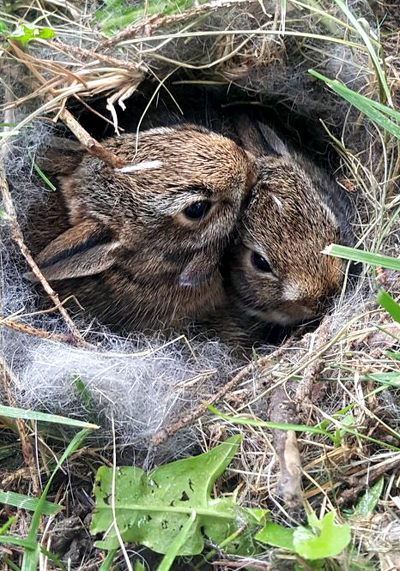
We all share our gardens with a multitude of other creatures. Some of them, such as birds, bees, and butterflies, I’m always glad to see, but others not so much.
Until five or six years ago I’d never seen a rabbit in my garden here in the middle of Ann Arbor, but now they’re everywhere. My wife says they’re cute and insists on calling them bunnies, but since they love to eat my crocus, larkspur, and other flowers, I pretty much hated them – until recently.
I was mowing our small backyard for the first time in maybe a month, and the grass was unusually long. I had gotten to the middle of the yard when I noticed a matted down clump of dry grass in the strip I’d just mowed. As I bent down to pick it up – it wiggled.
I jumped back, not knowing what might be under it, but then I cautiously pulled some of the grass aside and there, lying on its side, was a tiny rabbit. At first I was worried that I’d injured it, but it seemed unharmed, although no doubt traumatized by the mower passing overhead. I covered it back up as best as I could (I’m not a barbarian) and added some dry ferns to replace the protective grass I’d cut.
A rabbit building its nest in the middle of my lawn seemed crazy to me, but I later read that it actually makes sense because predators rarely venture there. I also learned that baby rabbits have virtually no scent, and that the mothers nurse their babies for just a couple of minutes twice a day, keeping their distance the rest of the time so predators won’t be drawn by their adult scent.
I still wasn’t a rabbit lover, but the next day something happened that amazed me. I was watering some plants in the backyard when I noticed a squirrel heading over towards the nest. All of a sudden, a rabbit burst out of a nearby patch of daylilies and launched itself high in the air as if to jump on top of the intruder. The squirrel ran off a couple of yards, but that wasn’t enough for the mother rabbit. She leaped at it again, like a superhero swooping down from the sky, and the squirrel gave up and ran away.
As a man who loves his kids and grandkids more than anything, I admired that mother rabbit. For a moment I saw the world through her eyes and discovered that we have more in common than I thought. Of course I’ll still curse when I find my plants nibbled on, but I felt my heart grow a little bit bigger that day, and I’m grateful for that. (September 2019)
Eat Your Weeds – Delicious, Historic Purslane
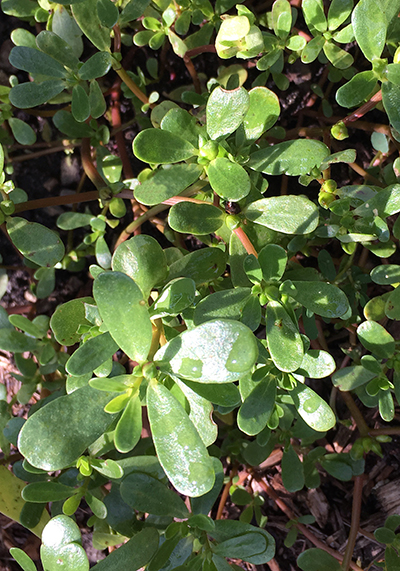
Purslane is the weed of the moment in my garden right now. I swear if I look away for just a day or two, areas that were perfectly weeded are covered with big sprawling mats of it.
With its flat, succulent leaves, purslane is part of the Portulaca genus which also includes the heirloom annual moss rose. Its seeds germinate best when soil temperatures reach 90 degrees, which explains why I’m seeing so much of it right now. And it does grow quickly, producing seeds just three weeks after it sprouts – which can remain viable for up to 40 years! Plus any pieces that get missed while you’re weeding can root and grow into new plants, so I’m sure I’m going to be battling purslane in my garden forever.
But here’s the good news – purslane is both tasty and nutritious, and it has a deep history.
“The moisture-rich leaves are cucumber-crisp, and have a tart, almost lemony tang with a peppery kick,” writes Laura Vozzella in the Baltimore Sun, and it’s frequently compared to watercress and spinach (though to my taste buds it’s milder than all of the above). It’s also rich in Omega-3 fatty acids, vitamin A, vitamin C, iron, magnesium, and even melatonin.

“Fresh young plants” are best, writes Sandra Mason of the University of Illinois Extension, “especially young leaves and tender stem tips.” She recommends eating it “in salads or on sandwiches instead of lettuce or pickles. Next time order a ham and purslane on rye,” and adds that purslane “can also be cooked as a potherb, steamed, stir-fried, or pureed.”
According to Wikipedia, “archaeobotanical finds … are common at many prehistoric sites” in the eastern Mediterranean, and by the Roman era purslane’s “healing properties were thought so reliable that Pliny the Elder advised wearing the plant as an amulet to expel all evil.”
In his great Herbal of 1597, Englishman John Gerard described two forms, “garden purslane” and the similar but smaller “wild purslane” (pictured here) which “cometh up of his own accord in allies of gardens and vineyards.” (Sound familiar?) It was “much used in salads, with oil, salt, and vinegar,” he said, and he listed over a dozen herbal uses for it, from provoking appetite and soothing toothaches to treating hemorrhoids and “killing worms in small children.”
I could go on and on – who knew a weed could be so interesting? – but I’ll just recommend a couple of excellent articles if you want to explore further: the Baltimore Sun’s “Purslane: A Weed Worth Eating” and “What to Do With Purslane” at Epicurious.com.
Happy weeding – and eating! (August 2019)
For Better Peonies, Cut and Destroy Foliage Now
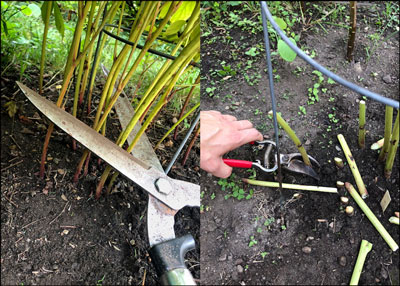
Peonies are rarely troubled by pests or diseases, but here’s an easy, poison-free way to make sure yours stay that way. We do it every fall.
1. Don’t wait. Cut them down early enough that the leaves are still green. If you wait until they’re dry and brittle, they’ll be much harder to clean up – and disease organisms can over-winter on any scrap that’s left behind.
2. Start with hedge-clippers so you can cut many stems at once. Chop them off a few inches above the ground, and pile the foliage to the side.
3. Follow up with pruning shears to cut the remaining few inches off as close to the ground as possible – being careful not to injure the pink buds of next year’s stems which are at or just below the soil surface.
4. Bag all leaves and stems in plastic trash bags. DO NOT COMPOST. Your goal is to leave virtually nothing behind that disease organisms can over-winter in.
5. Sterilize your tools by dipping or rubbing them with bleach or alcohol before going on to the next peony.
That doesn’t sound so bad, does it? And remember, healthy peonies bloom more! (October 2018)
Good News about the Red Lily Leaf Beetle
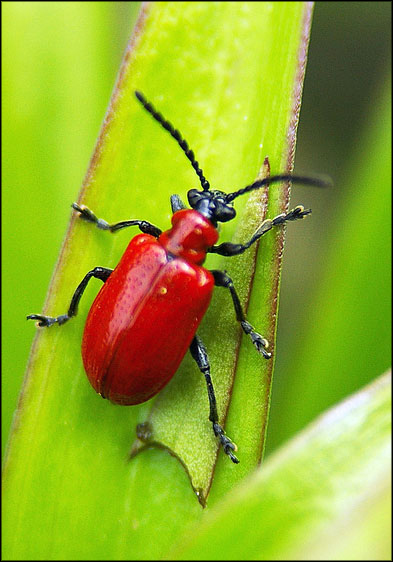
When my sister and her family visited us from Massachusetts this past summer, my brother-in-law had some exciting news – after years of being plagued by red lily leaf beetles, he’d seen very few in their garden this year. The parasitic wasps seem to be working!
If these voracious beetles aren’t in your garden yet, they’re on their way. They first appeared in Massachusetts in 1992 and have since spread throughout New England and into New York, Pennsylvania, Michigan, Wisconsin, Iowa, and Washington.
To control them, researchers at the University of Rhode Island have released three species of tiny parasitic wasps. Two of these have slowly spread throughout New England, and it looks like they’re finally making a difference in my brother-in-law’s garden.
To learn more, see Margaret Roach’s excellent interview with Lisa Tewksbury of the Rhode Island University Biological Control Lab at AWayToGarden.com/controlling-lily-leaf-beetles-u-rhode-islands-lisa-tewksbury/.
And if you’re looking for a beetle-resistant lily, Tewksbury highly recommends ‘Black Beauty’. Although adult beetles may feed on it a little, she says, the larvae never do because eggs laid on it just die. (Sept. 2018)
Learning from You: Are Peonies Really Rabbit-Proof?

Until a few years ago I don’t think I’d ever seen a rabbit in our garden here in the center of Ann Arbor, but now they’re everywhere. They devoured my glory-of-the-snow this spring, and my neighbor says they’re the reason why so few of our self-sowing larkspur bloomed this summer.
Peonies, though, are not one of their favorite foods, according to UK nurserywoman Claire Austin who has grown hundreds of them since the 1980s when her father, the famed rose breeder David Austin, gave them up for roses.
“Did you know that peonies are rabbit-proof?” she writes in the May 2018 issue of Country Living. “If you have rabbits that like nothing better than to nibble from your borders, get planting peonies! Rabbits do not like the taste . . . and won’t be tempted to snack on their roots, stems or blooms.”
But Claire gardens in Wales, and we’re wondering if what she says is also true for American rabbits. A few stalks of my peonies were chewed on for the first time this year, and I blamed the rabbits. It was minor damage, but I’m still wondering – do the rabbits in your garden leave your peonies alone? (August 2018)
A Great New Guide to Bugs
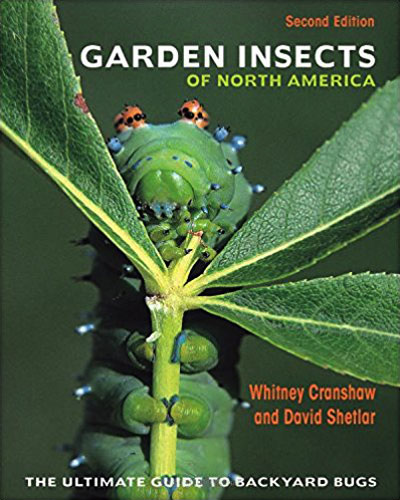
Garden Insects of North America, second edition – I got a copy of this book for my birthday recently, and it’s even better than I expected. First of all it’s BIG: 704 pages, weighing a hefty five pounds. It’s so well bound, though, that it opens flat for easy reading, and the cover seems so durable that I won’t hesitate to take it with me into the garden.
Then there are the photos: 3300 of them, all in full color, and helpfully organized into chapters such as “Insects That Chew on Leaves and Needles.” I admit my first reaction to them was “gross!” Most bugs, after all, aren’t as photogenic as the caterpillar on the cover, and it’s daunting to see page after page of damaged plants. But before long I was discovering insects I’d seen before but didn’t know what they were – such as the tiny, mosaic-patterned ailanthus webworm moth – and I realized this book is going to be both useful and fun.
Superstar garden blogger Margaret Roach recently called it “a must for every gardening household,” and I couldn’t agree more. One caution, though: be sure to get the brand-new second edition which is bigger and better than the 2004 original. (Dec. 2017)
Protect Peonies and Iris with an Easy Fall Clean-Up
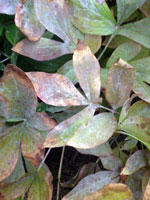
For healthier plants and even more flowers, give your peonies and iris a simple fall clean-up.
PEONIES – Although peonies are generally care-free, they can be afflicted by powdery mildew (pictured here) and other fungal diseases. To prevent spores from overwintering, cut peony stems as close to the ground as possible, carefully bagging everything as you go, and dispose in the trash instead of composting. For best results, do this earlier rather than later, before the leaves dry up.
IRIS – Fall is also the best time to control iris borers. Borers hatch in spring from eggs laid in fall on iris leaves and anything similar that’s close by. To destroy them, simply wait until after a good hard frost kills the adult moths and then (a) cut back all leaves to a couple of inches and (b) remove, bag, and trash – don’t compost – the clippings and any debris or mulch that’s near the plants.
Simple, right? And your plants will reward you! (Sept. 2017)
Two Great Tulips Overcome Deer, March Planting
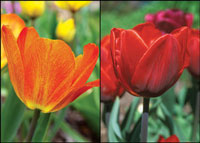
Heirloom bulbs are survivors, but even we were surprised by these two reports:
Here’s what our good customer Marianne Schmidt of zone-5b Stuyvesant, NY, had to say about one of our most fragrant tulips – although please note that we can’t guarantee it will work for you:
“Last spring the deer devoured all of my tulips EXCEPT ‘Generaal de Wet’. I don’t know if it was the fragrance or color that turned them off, but this year I’m pinning all of my tulip hopes and expectations on this beautiful tulip!”
And though we’d never recommend planting tulips THIS late, we were happy to get this news about one of our oldest tulips from our long-time customer Tara Fitzpatrick of zone-6a South Hadley, MA:
“Testimony for your ‘Couleur Cardinal’ – I forgot a bag I had intended to force inside in the basement fridge all winter. I found and planted them in the garden in March during a thaw, and they bloomed perfectly in May!” (Sept. 2017)
Bulb Protection from the Dollar Store
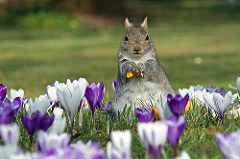
Although some bulbs are rarely bothered by animals (see our complete list here), others are quite tasty. If, like us, you can’t live without tulips, lilies, and other animal favorites, here’s a tip from fellow gardener Louise Heern in the August issue of Fine Gardening:
“Trying to garden in the mountains of Colorado is no easy task. Some plants may be deer or rabbit resistant, but voles and pocket gophers don’t care what kind of roots they eat.
“To protect plant roots from these burrowing critters, I buy wire baskets from the dollar store and sink them into the ground, leaving an inch or two above the soil to prevent voles from coming in over the top. I then plant the root-ball inside the basket, backfilling with soil to the appropriate level. The basket rim can be hidden with mulch if your plant doesn’t cover it.
“Wire baskets can also be turned upside down and secured with U-shaped pins to protect new seedlings from rabbits and chipmunks.” (Oct. 2016)
Thwart Animals with “Noxious and Unpalatable” Bulbs
We love animals, but we love flowers, too. In a recent article for the Associated Press, our good friend Dean Fosdick passed along some advice from an esteemed colleague about bulbs that are “noxious and unpalatable to foraging wildlife:”
“‘Members of the amaryllis family are the best long-term choice for predator control, particularly daffodils, snowdrops, and snowflakes,’ said Christian Curless, a horticulturist with Colorblends, a wholesale bulb company. . . . All contain lycorine, an alkaloid both repellent and toxic to animals. . . . ‘These plants we label as deer-and-rodent-“proof” because even a starving animal won’t eat them. The bulbs we classify as “resistant” are, for reasons we often don’t understand, not preferred by deer or rodents or both. Bulbs in this category include allium, hyacinth, fritillaria, and anemone.”
Other great animal-proof members of the amaryllis family include our fall-planted sternbergia, oxblood lilies, surprise lilies, and red spider lilies – which you can order for next fall beginning Dec. 1 – and our spring-planted crinums.
And for our tips for protecting bulbs like lilies and tulips that animals love to eat, see the Pests and Diseases section of our Newsletter Archives. (Nov. 2015)
Earthworms: The Good, the Bad, and the Latest Research
“Why would anyone want to destroy earthworms?” we asked in our July article “Advice from 1683: Killing Earthworm Pests with Tobacco.” In the 1600s it was to keep unsightly worm castings from blemishing gravel paths, but today there’s a different reason.
“In northern parts of the country, earthworms are not native,” our good customer Robin Schachat of Shaker Heights, Ohio, explains. “It’s now thought that the greatest loss of the duff layer in our native forests is due to earthworm infestations, not to deer browsing.”
Although worms can be beneficial in the disturbed and compacted soils of our backyards, since the last glaciers retreated some 14,000 years ago there have been no native worms in the area once covered by them —north of NYC and the Ohio and Missouri rivers, and in the Rockies and parts of Washington — so in those areas forest ecosystems evolved without worms.
Recent research at the University of Minnesota has shown that “without worms, fallen leaves decompose slowly, creating a spongy layer of organic ‘duff.’ This duff layer is the natural growing environment for native woodland wildflowers. . . . Invading earthworms eat the leaves that create the duff layer and are capable of eliminating it completely. Big trees survive, but many young seedlings perish, along with many ferns and wildflowers.”
Although there are native earthworms in unglaciated parts of the country, if you live further north we encourage you to learn more at the Invasive Earthworms page of the Minnesota DNR and at the Great Lakes Earthworm Watch. (Oct. 2015)
Earwigs: Surprisingly Human
You may shudder when you spot an earwig in the garden, but they have their good side, too. They feed on aphids, mites, and insect larvae; they provide food for birds, toads, and other creatures; and — believe it or not — they care for their eggs and young.
After mating in the fall, the male and female earwig spend the winter together in a shallow burrow in debris or soil. In early spring the female lays her eggs and then tends them for a week or so until they hatch, continuously cleaning them to prevent the growth of fungi and protecting them from predators. When they hatch, the nymphs cluster under their mother like baby chicks and she feeds them by regurgitating, just like birds do.
Although there is one native American earwig, most of them in the US today are the European Forficula auricularia which arrived in 1907 and has since spread across the country. Here in the upper Midwest, older gardeners can remember life B.E. — before earwigs. According to the University of Minnesota Extension, for example, earwigs “first became noticeable in Wisconsin in the early 1980s and Minnesota in the early 1990s.”
Despite their good points, if earwigs are chewing up your prized dahlias and other flowers, you’ll probably want to control them. Earwigs feed at night and hide in cool, moist places during the day. Since mulch and garden debris are favorite hiding places, you can limit their damage by keeping the area at the base of favorite plants clear of both.
If that’s not enough, you may want to try home-made earwig traps. You can stuff a cardboard paper towel tube with straw or weeds, for example, and lay it on the ground near vulnerable plants. A rolled, moistened newspaper or a short length of an old hose will also work. In the morning, shake the earwigs out into a bucket of soapy water or simply stomp on them. Another trap can be made by filling an empty tuna fish can with a half-inch of vegetable oil. Empty and refill as needed. And good luck! (Aug. 2015)
Advice from 1683: Killing Earthworm “Pests” with Tobacco
Here’s a weird bit of garden advice for July from the Kalendarium Hortense or the Gardener’s Almanac written by John Evelyn in 1683:
July: “Now (in the driest season) with brine, pot-ashes, and water, or a decoction of tobacco refuse, water your gravel walks, etc. to destroy both worms and weeds, of which it will cure them for some years.”
Weeds, yes, but why would anyone want to destroy earthworms? Although we certainly don’t advocate it, back when hard-packed gravel was the paving of choice for garden paths, worm castings on the surface were considered as unsightly as weeds.
Brine and wood ashes kill weeds by making the soil too salty and alkaline for them, and tobacco kills worms just like it does humans. Tobacco water and tobacco powder were commonly used as pesticides well into the 20th century, as was tobacco smoke in greenhouses. Even today tobacco is sometimes recommended as an organic pesticide — which may sound good, but remember, whether it’s organic or not, it’s still a dangerous poison. (July 2015)
To Protect Your Lilies, Plant Alliums
Our good customer Amy Reynolds of Saint Louis, Missouri, emailed us this helpful tip:
“Your lily bulbs are fabulous! I popped them in the ground immediately. To protect them from an abundant local rodent population, I’ve planted them (as I always do with lilies) with several allium companions. I’ve found that squirrels and chipmunks won’t excavate past the alliums to get to nearby lily bulbs while they’re dormant, and the rabbits won’t go near allium foliage come spring.”
To try this yourself, why not order a few of our fabulous lilies and alliums right now? (Oct. 2014)
Mildew on Your Peonies? Act NOW to Control It
Although peonies are rarely bothered by pests or diseases, powdery mildew has become a problem in some areas. We first wrote about it in 2012, and expert Don Hollingsworth recently offered his perspective in the APS Bulletin. Don has been growing peonies since the 1930s but he says “it was not until 2014 that I noticed the striking sight of white mildew” on a few of the hundreds of peonies at his farm in Missouri. He searched the web but found no explanation as to “why powdery mildew is only now taking hold on peonies, while it has long been known to affect other commonly grown ornamental plants.”
To control it, Don says “the first line of defense is to clean up and destroy all infected plant parts at season’s end” to prevent spores from overwintering — and earlier is better than later. Instead of waiting until late fall, cut infected plants to the ground and carefully bag and remove all foliage “before the leaves dry up, which is best accomplished well before frost.” Don also offers a recipe for a preventative spray by the Massachusetts Master Gardeners: “In a quart of water add a few drops of liquid dish soap and a teaspoon of baking soda.” That’s similar to the spray we recommended two years ago: Mix 1 tablespoon of baking soda and 1 tablespoon of horticultural oil (or vegetable oil) in a gallon of water. Spray weekly throughout the spring, using a new mix every time and avoiding overuse to prevent a build-up of salts in the soil. (late Sept. 2014)
Rogue Voles Teach Cornell Scientist about Animal-Resistant Bulbs
When voles ate bulbs intended for a study on deer-resistance, Cornell University’s Bill Miller made the best of it. In the fall, Miller had potted up the bulbs and put them into cold storage. Unfortunately in spring he discovered that “during the winter, prairie voles had taken up residence in the stacks of crates and had eaten more than 35% of the bulbs. We found two large nests of voles, and the youngsters were quite happy, well fed, and growing fast from their nutritious meals. . . . Of course we were not happy with this, but we used it as an opportunity to learn some things about vole feeding and flower bulbs.” The voles’ favorite bulbs included tulips, crocus, Anemone blanda, and Chionodoxa luciliae, but they avoided those listed below. Deer would, too, Miller points out, since deer and voles are known to have similar tastes.
Hyacinths — “Bulbs were not attacked and shoots were perfect when uncovered. . . . From this we can conclude that hyacinths are pretty immune to attack from voles, and my own experience suggests that deer usually leave hyacinths alone.”
Daffodils — “Voles dug in about 10% of the pots but did not damage the bulb or emerging shoots” — and most gardeners know that daffodils are reliably deer-resistant.
Other bulbs that “experienced little or no damage” included snowdrops, snowflakes, cyclamen, trout lilies, and crown imperial. Others that were “injured but not destroyed” included alliums such as Allium sphaerocephalum (10% damage), winter aconite, and Siberian squill. (Sept. 2014)
A Squirrel-Proof Tulip???
As any chipmunk or deer will tell you, tulips are one of the tastiest bulbs. That’s why we were surprised to get this email from our good customer Jane Baldwin (who you may remember from “Jane’s Easy Daffodil Baskets” at our Bulbs in Pots page):
“I had a quite a bit of loss with the bulbs I grew in pots this year. The extreme cold made it very difficult to keep them from deep-freezing, even in my garage, and I lost several pots that I had not protected well enough. So this spring I had just a few blooming on my patio, and then there were all these hungry red squirrels constantly rummaging in them. A curious thing happened, though, with the pot of ‘Prinses Irene’ tulip — no damage during the month or so it was on the patio. It was the only pot that wasn’t’ disturbed by the critters! I remember the basket I had them in last year was never touched either. I think I may be on to something, so I am going to give it a try again this fall. I may just have found a squirrel-proof tulip, at least in pots on the patio. Have you ever heard of anything like this before?”
No, Jane, we haven’t — but maybe one of our newsletter readers has? Although it’s probably nothing more than a happy coincidence, we’re definitely keeping our fingers crossed. (June 2014)
Sickly Glads? The Culprit May be Almost Invisible Thrips
Glads are one of the easiest bulbs to grow, and they last wonderfully long in a vase. Unfortunately thrips are an almost microscopic pest that can attack them, sucking the life out of their leaves and buds. If your glads have brown or silvery streaks on their leaves, if the flowers are mottled with white, or if their buds fail to open, there’s a good chance thrips are the problem. To learn more, see our “Protecting Your Glads from Thrips.” (Aug. 2013)
Got Deer? “Daffodils are the Secret”
In her wonderful book Gardening for a Lifetime, Sydney Eddison writes about naturalizing daffodils in a meadow and young woodland, outside her garden fence but untouched by deer:
“I have begun working on . . . an extension of the garden that will be beautiful and require no attention whatsoever. Daffodils are the secret. To digress briefly, when I began planting daffodils in the field, my helper was our first Jack Russell terrier puppy. It was slow going. Besides the difficulty of digging into the rough, rocky hillside, I had to keep an eye on Abby.
“Suddenly a doe bounded through the field behind us. For a second the puppy froze, and then she was off like a shot. Being fleet of foot in those days, I managed to catch her, but that was the end of daffodil planting for the day. Every year since, I have added to the planting, but last fall Erica [Sydney’s garden helper] did most of the work, putting in about a dozen new clumps, with six or seven bulbs in each hole. It was wonderful in April! Looking out over the top of the computer . . . all I could see was waves of daffodils sweeping farther and farther up the hillside.
“Since that single doe dashed past Abby almost thirty years ago, the deer population has exploded, and the forest shelters an expanding herd . . . but they don’t touch daffodils. So once planted, these hardy bulbs require no protection and no care. . . .
“The new daffodil project involves a part of the field that proved too steep and rocky to mow. Tree seedlings colonized the slope and have now become strong saplings and young trees. I’m going to have them thinned out, and then we can start a new planting of daffodils among the trees. In time, I will have a carefree new woodland garden that I can see without setting a foot out of doors.” (Aug. 2013)
Protect Your Daylilies with Vick’s Vapo-Rub
Got deer? Here’s a tip from our friend Diana Bristol of Bloomingfields Farm, deep in the deer-infested wilds of Connecticut, who swears by it to protect her hundreds of hostas and daylilies: Put a little Vick’s Vapo-Rub on your thumb and index finger and then touch bud or leaf with it here and there. Diana says touching the smallest buds on a stalk is especially effective because the Vapo-Rub will remain on them for a long time before they get big enough to bloom and drop. (March 2013)
Although we’ve never looked at the browning, beat-up leaves of our iris and thought, “Hey, those would be great for basket-making,” our good customer Frances Garrison makes it look easy and appealing in her FaireGarden blog. If you decide to try it, please send us a photo of your results and we’ll share it with our readers — and no matter how your basket turns out, we promise not to laugh. (Nov. 2012)
Ghostly Trend: Mildew on Peonies
I’ve been growing peonies in my home garden for 30 years. They’re typically trouble-free plants, but early this fall, for the first time ever, a couple of them were covered with what looked like powdery mildew — and I soon noticed other ghostly white peonies all over town. So I called Carmen Leskoviansky of the University of Michigan’s world-class peony garden and asked her: what is it, why is it so common this year, and how should I treat it?
It’s just plain old powdery mildew, Carmen assured me, and it’s been a recurrent problem in the UM peonies. Some years it’s worse than others, and Carmen thinks it may be especially bad this year because the summer’s extreme heat and drought stressed the plants, making them more susceptible. Shade and poor air circulation also favor the disease. “We don’t usually treat for it,” Carmen added. “However, as with managing botrytis, I always tell folks to trash the foliage in the fall instead of composting it, since spores can overwinter.” Warmer winters may be allowing more spores to survive, which could be another reason the disease seems to have become more common recently.
The good news is that it’s mostly a cosmetic problem, and by the time it shows up in the fall the plants are ready to go dormant anyway. I cut my infected plants to the ground, carefully cleaned up all the debris, plastic-bagged it, and threw it away. In the spring I may follow up with a fungicide spray, possibly this organic one that Kelly, our Farms Manager, recommended: Mix 1 tablespoon of baking soda and 1 tablespoon of horticultural oil (or vegetable oil) in a gallon of water. Spray weekly throughout the spring, using a new mix every time, and avoid overuse to prevent a build-up of salts in the soil. Learn more about controlling mildew here. (Oct. 2012)
Rodent Problems? Protect Your Bulbs with Chicken Grit
Although many bulbs are animal-resistant (see a complete list here), if burrowing rodents attack yours, here’s a tip from Joyce Kelly of Ellicott City, Maryland, in the October 2012 issue of Fine Gardening:
“After trying to discourage voles and chipmunks by using wire baskets for bulbs and hostas, I now, instead, use chicken grit. It works great, deterring these critters and providing good drainage. For bulbs, just place a 1/2-inch-deep layer of grit in the hole, add the bulb, and cover with grit to the top of the bulb, filling the rest of the hole with soil. For hostas and other plants with fleshy roots, put grit in the bottom of the hole and then mix in grit with the soil that surrounds the plant.”
Chicken or poultry grit — which is crushed granite, shale, or oyster shells — can be found at farm supply stores and some pet and hardware stores. We picked up a 25-pound bag at our local Tractor Supply Company for $7.99. A similar product which we’ve recommended for years is PermaTill or VoleBloc. All are non-toxic and earth-friendly, and if you give them a try we’d love to hear how they work for you. (August 2012)
Now’s the Time: Fall Clean-Up Beats Iris Borers
Now is the best time to conquer iris borers — and it’s easy. Cleanliness is the key. In the fall, iris borer moths lay their eggs on iris leaves and anything similar that’s close by. In the spring, the eggs hatch into tiny grubs that crawl up the leaves and then chew their way down into the rhizomes where they wreak havoc. By eliminating the eggs in the fall, you’ll save yourself a lot of grief. Simply wait till after a good hard frost (which kills the adult moths) and then (a) cut back all iris leaves to a couple of inches and (b) remove all dead leaves and stalks as well as any debris and mulch that’s near the plants. To be safe, don’t compost this stuff; burn it or throw it out with the garbage. Repeat this simple, poison-free clean-up every fall and you’ll have very little problem with borers. Now isn’t that easy? Learn more at www.ksre.ksu.edu/news/story/fall_cleanup110410.aspx . (Nov. 2011)
Protect Bulbs from Hungry Rodents
Although some bulbs are rarely troubled by animals (for a complete list, choose “Animal Resistant” in our awesome Heirloom Bulb Search), others may need protection from burrowing rodents such as chipmunks. Here’s one inexpensive solution recommended by Sydney Eddison in A Patchwork Garden:
“My bulb losses have been considerably reduced by planting tulips in miniature plastic laundry baskets available from hardware stores. I cut out the solid plastic bottoms and replace them with rectangles of half-inch mesh hardware cloth. Then I make a planting hole in the border, install the prepared basket, add a thin layer of earth over the wire mesh, and put in the bulbs. Their roots grow right through the hardware cloth and through the plastic mesh sides of the basket. It is worth the additional trouble. I rarely lose a protected tulip to the mice, voles, shrews, and other small, greedy creatures that ply the mole runs during the winter.”
For a stronger basket, check out the ones offered by GO-pher-AWAY. An even easier solution is planting bulbs in the crushed shale which is sold as PermaTill or VoleBloc, and you’ll find other tips at our “Protecting from Animals.” (Sept. 2011)
Can Aspirin Help Heal Your Plants?
We’re not doctors, and we can’t vouch for the accuracy of this report from CleanAirGardening.com, but we found it intriguing and thought you might, too.
“It sounds like a weird idea, but recent research suggests that the old adage ‘take two aspirin and call me in the morning’ works just as well for plants as it does for us. Not only does aspirin appear to speed germination, it seems that it can also boost a plant’s immune system, helping it resist the onset of fungal and bacterial diseases. This may also be why adding an aspirin to a vase of cut flowers helps them stay perky longer: the aspirin fights microbes that would otherwise enter through the cut ends.
“It turns out that most plants naturally start synthesizing salicylic acid, the active ingredient in aspirin, when under stress. Sometimes, though, they don’t make enough to help in time, and as a result they fall prey to disease. That’s why a couple of aspirin occasionally can help an ailing plant. But don’t overdo it: 1.5 uncoated aspirins tablets in two gallons of water are sufficient. You should add a few teaspoons of liquid soap to the mix to help it stick to the plants, and apply it as a foliar spray every three weeks or so.” (Nov. 2010)
Canna Virus: Your Questions Answered
As announced earlier, we’ve regretfully decided to stop selling cannas due to a relatively new and little-understood virus that’s attacking cannas worldwide. Many of you emailed us in sympathy and support (thanks!), and we were happy to hear that many of your cannas are still healthy and happy.
You also asked us a lot of questions, so for answers we turned to our friend Keith Hayward of the UK National Collection of Canna. The virus devastated cannas in Keith’s part of the world years before it caused major problems here in the US, and Keith is utterly frank. Learn more here. (Sept. 2010)
Divide Iris and Defeat Borers: Now is the Time!
If your iris plantings have become over-crowded, or you want to share some with friends, now is the time to dig and divide them. “It’s easy, and fun,” our friend Ken Druse wrote recently at RealDirtRadio.com. “I dig up my iris rhizomes with a garden fork when they are dormant — now. Most of the soil will fall off the thick rhizome and reveal slender roots. I trim back the leaves into ‘fans’ and cut off the oldest section of rhizome (which will not bloom again). I dip the rhizome (holding it by the leaves) in a 10% solution of household chlorine bleach for about ten seconds. I set them out to drain on some newspaper, and then replant with the top of the rhizome just at the surface of the soil. Sun-baked rhizomes bloom best.”
“Older varieties of bearded iris do not need dividing as often as newer ones,” Ken adds. To see the six heirlooms we’re offering, click here. To learn more about dividing iris and combating borers, listen to Ken’s July 3 podcast. (July 2009)
Book of the Month: The Truth About Organic Gardening
Cool-headed, down to earth, and funny, Jeff Gillman is a hort science professor who’s trying to help gardeners make their own, educated decisions about gardening organically or not. Instead of polemics, he offers clear explanations backed up by plenty of facts and a broad context for weighing the pros and cons.
Most of the book is devoted to an item-by-item discussion of all sorts of organic and synthetic choices for improving the soil and controlling weeds, insects, and other pests. For each option, Gilman includes its Environmental Impact Quotient, a number which quantifies (as best as possible) just what it says, and he ends his discussion of each with a handy three-part summary of Benefits, Drawbacks, and The Bottom Line.
The Truth About Organic Gardening is currently ranked as Timber Press’s #11 best-selling book. Though I borrowed it from our local library, after reading it I was so impressed that I bought a copy for my staff to read and for future reference. I expect we’ll be using it a lot, and my guess is you would, too. (June 2009)
If Javelinas Roam Your Garden, Plant Iris!
Though we didn’t include bearded iris on our recent list of animal-resistant bulbs, our good customer Louise Coulter of Payson, Arizona, emailed us to vouch for them:
“In my area which is at 5,000 feet in Arizona’s northern section there is an animal called javelina or wild pig. With cloven hoofs, tusks, and large foraging families, it devastates unprotected bulbs in gardens — except for iris. Seems they can’t eat iris. So at thousands of homes here, where the yards are unfenced, iris naturalize and are ubiquitous. Seems the local nurseries obtained a limited color palette of them each year, so one can almost tell how old the bulbs are by their color. For years one could only get shades of variegated purple and a lovely pale salmon.” (Nov. 2008)
And You Thought You Had Animal Problems!
On her fall order, our good customer Frances Webb of Tuolumne, California, added:
“Your bulbs all bloomed well and were spectacularly beautiful. I lost one dahlia to a gang of thug quail, though. Charlie may want to visit.”
Charlie is a very tough cat, but even he’s afraid of California’s quail gangs. Does anyone have any suggestions for controlling these terrifying thugs? (late Oct. 2008)
Do Animals Eat Your Bulbs? Try Planting These!
For a quick list of bulbs that animals rarely eat, click the “Animal Resistant” box at our easy Advanced Bulb Search.
Daffodils and snowflakes (Leucojum) are usually completely animal-proof, and other bulbs that most animals won’t touch include alliums, Camassia, glory-of-the-snow (Chionodoxa), Colchicum, Crocus tommasinianus, winter aconite (Eranthis), crown imperials, snowdrops (Galanthus), hyacinths, Spanish bluebells (Hyacinthoides), Ipheion, grape hyacinths (Muscari), silver bells (Ornithogalum nutans), and Scilla siberica.
Tulips and lilies, unfortunately, are a favorite on most animal menus. For tips on keeping them safe, see “Protecting from Animals” in our online Planting and Care. (Oct. 2008)
Counterpoint: When Is Animal Control Just Plain Cruel?
A while ago we published some tips from our readers for protecting bulbs from animals. This response from our good customer Denise Cowie of the Philadelphia Inquirer made us think twice about some of those suggestions:
“I was dismayed by the ‘helpful hints’ to get rid of ‘pests’ by using liberal amounts of cayenne pepper and, even worse, habanero peppers. If the gardener has to wear gloves to handle this stuff, and has to be warned not to get it anywhere near face or eyes, imagine what this does to innocent animals who have no intention of harm, but are just looking to do what nature dictates. I want to protect my bulbs as much as the next person, but some of these suggestions seem potentially cruel. A squirrel or cat that gets this stuff on its paws, then possibly into its eyes, would be in agony.” (Aug. 2005)
Tips for Success: Earwig Control
Our good customer Laura Baxter or Zillah, WA, writes:
“One of the best and most organic ways of controlling earwigs is to get a cottage cheese or similar container, use a hole-punch to make holes just under the rim, put a few tablespoons of vegetable oil in the bottom, fill it a third of the way up with soy sauce, put the lid back on, and bury it up to the holes. The earwigs love this even more than flowers, and when they fall in they drown. It really works, and without poisoning the earth.” (2005-06 catalog)
Link of the Month: Finding Expert Local Advice
A great local resource for gardeners is your Cooperative Extension Office. Every county has one; there’s even one in Manhattan! Most have a help line staffed by Master Gardeners who can identify plants and pests for you and answer many, many gardening questions. For the phone number of your county’s, go to the new www.csrees.usda.gov/Extension/index.html and click on your state. (Dec. 2004)
Do Rodents Eat Your Crocus? Here’s a Solution!
Joe Eck, writing in Horticulture (March/April 2004), says:
“Crocuses . . . gladden hearts of gardeners and bees, who travel great distances to find their pollen-rich anthers, almost the first, for them, of the year. But Crocuses can be heartbreakers, since far less benign creatures than bees are partial to their corms. . . . For this reason, we learned years ago to plant all our crocuses in black plastic nursery cans [pots], each covered with a lid of hardware cloth, its corners bent down to clasp the edges. The cans are buried so that the rims and lids lie about two inches below the surface of the soil, and the crocus corms are planted deep, up to eight inches, which prevents them from splitting into tiny cormlets too small to flower. A two-gallon can will hold a dozen species crocus corms comfortably and still leave room for multiplying. Our oldest crocuses planted in this way have been in their cans for 15 years undisturbed, and still flower abundantly each spring. Also, the perennials that come later grow happily over and into the cans, seeming to cause the crocuses no discomfort at all.” (Oct. 2004)
Voles, Yellow Labs, and Bulb Safety
Our good customer Faye Bailey Timm of Chesapeake, Virginia, writes:
“Our problem with voles has been alleviated by planting EVERYTHING with Permatil (ground up slate). We also keep our yellow lab away from young flowers by posting two-foot-high green stakes by them. This provides a visual barrier until the plant is large enough to speak for itself. The dog’s presence has slowed down the rabbits, though now we have the dog issue instead!” (Oct 2004)
Protecting Your Plants from Armadillos
Our creative customer Sharon Black of Paris, Texas, writes:
“I finally found a solution for armadillos. In the spring, I place what we Southerners call hog wire on top of the prepared soil in my beds. This wire is constructed with 4 x 4 inch square openings and can be cut to fit with wire cutters. I place decorative flat stones over the edges of the wire. Most annuals do OK when one is planted in each square. For larger plants, I just skip a square. Once the plants grow a little, the wire can’t be seen or it can be covered with mulch right after planting. The ’dillos can’t break the wire that is between the plants and soon get frustrated and give up.” (April 2004)
From Our Customers: Protect Your Bulbs with Hot Peppers
Cayenne pepper is a key ingredient in the pest-protection arsenal of our good customer and garden writer Ethel Fried of West Hartford, CT. She writes:
“The major threat to bulbs in my garden is tree rats (otherwise known as squirrels). To discourage them I sprinkle the planting hole liberally with cayenne pepper. Then before planting I spray my bulbs with Ro-Pel, place them in the planting hole, cover them with an inch or two of soil, sprinkle on more cayenne, fill the hole, and sprinkle more on top. This turns my planting areas a ghastly orange color – but only temporarily – and it works.
“When new shoots appear in the spring, I sprinkle them with cayenne a few times, too. Once they’ve sniffed or tasted the hot stuff, the squirrels tend to leave them alone.” Ethel also recommends “mixing squirrel-resistant bulbs like daffodils, alliums and Crocus tommasinianus in with the more susceptible tulips.”
Pam Sayre of Dearborn, Michigan, says ground cayenne works better than flakes, and that it needs to be renewed after rains. But for especially valuable bulbs, Pam recommends even hotter stuff:
“Get a pair of disposable or washable gloves to wear while you work with the very hot peppers such as habanero or the African peppers grown as ornamental plants. Take a ripe pepper and slice it into strips about one-fourth inch wide. Place your bulb or tuber in its hole, cover it completely with soil, add a pepper strip, and fill in the hole. Water and fertilize as usual. Do NOT touch your eyes or face until you have washed your hands thoroughly with soap and water, and wash or dispose of the gloves carefully. Once the plants are well established, you don’t need to renew the pepper unless you dig again in the same area or the critters get real hungry.” (Sept. 2003)
Your Tips for Squelching Garden Pests
Wow! So many of you emailed us great suggestions for dealing with pests that we’ll share them a few at a time over the next few issues. Thanks to all!
Debbie Caldwell of Farmingdale, Maine, has a most unusual suggestion: “Praying. To the individual spirits of the animals and the plants. This usually includes planting a little extra for the animals and other pests, while talking – praying – to them about it as you do it.” Debbie also recommends laying chicken wire flat, “not on posts,” all around your garden.
Joan Lindsey of Falmouth, VA, offered a simple solution: “Get a cat – or several cats – and they will patrol the garden and keep mice, voles and rabbits out.”
But Esther de Ipolyi of Houston, disagrees. “Cats,” she says, “are the most destructive force in my garden.” Esther keeps both cats and dogs away organically by sprinkling cayenne pepper around the edges of her garden. “I buy it in bulk cheaply at Middle Eastern grocery stores,” she says. She also recommends buying “long thin wooden skewers at the Asian markets – 100 for $1. Break them in half and stick them into the garden every few inches” where cats may be tempted to meddle. For smaller pests, Esther says possums are great. “I’m happy when they visit at night and eat the slugs! Bless them!” (Sept 2003)











